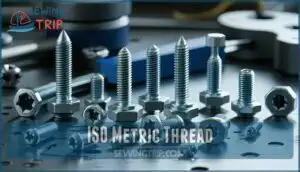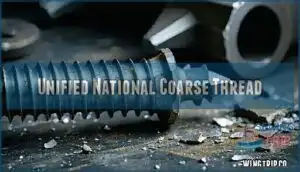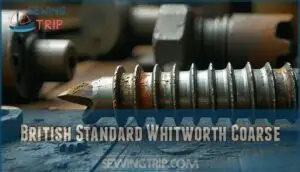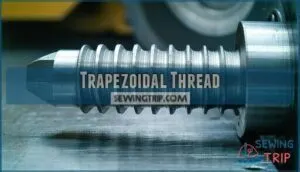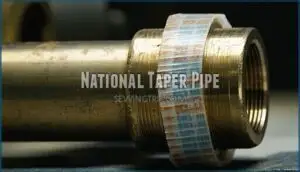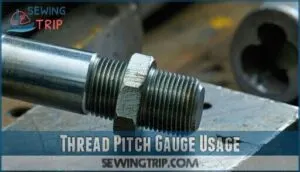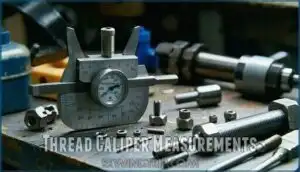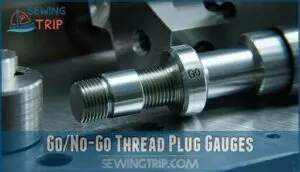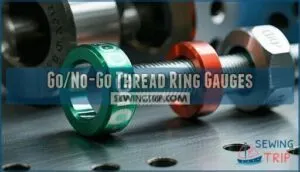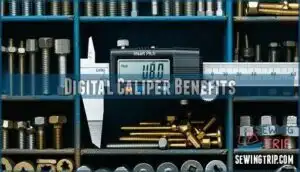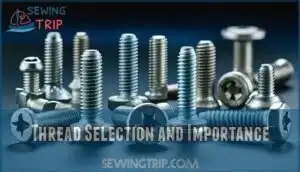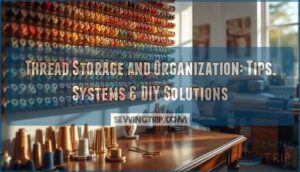This site is supported by our readers. We may earn a commission, at no cost to you, if you purchase through links.
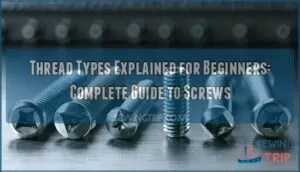
Each thread has specific measurements including pitch (distance between grooves) and diameter. Coarse threads work well for soft materials and quick assembly, while fine threads provide stronger connections in hard materials.
Different applications need different thread profiles – triangular for general fastening, square for heavy loads, and tapered for sealing joints. Getting the thread type wrong can mean loose connections or damaged parts, but there’s more to choosing correctly.
Table Of Contents
Key Takeaways
- You’ll encounter three main thread systems worldwide: metric threads (most common globally), unified national threads (standard in North America), and British Standard Whitworth for older equipment, so identify your region’s standard before selecting fasteners.
- You need to understand the difference between coarse and fine threads – coarse threads work better for soft materials and quick assembly, while fine threads provide stronger connections and better vibration resistance in hard materials and precision applications.
- You can measure and identify threads accurately using thread pitch gauges, calipers, and go/no-go gauges, which will help you match thread pitch (distance between grooves) and diameter specifications before assembly.
- You should choose specialized thread types for specific applications: square threads for heavy lifting, Acme threads for machine tools, trapezoidal threads for power transmission, and NPT threads for plumbing connections that need watertight seals.
Thread Basics Explained
You’ll find screw threads are spiral grooves cut into cylindrical surfaces that convert turning motion into straight-line movement.
Understanding thread basics helps you choose the right fastener for your project and guarantees parts fit together properly, which is crucial for ensuring that your project is successful and parts work as intended.
Definition of Screw Threads
Screw threads are continuous helical ridges that spiral around cylindrical or conical surfaces.
Tiny helical staircases that transform spinning motion into straight-line power, connecting our mechanical world one turn at a time.
Think of them as tiny staircases wrapping around a rod.
These thread forms convert rotational motion into linear movement, allowing you to fasten parts together or create mechanical advantage.
Thread geometry includes peaks, valleys, and angled sides that define specific thread terminology and standards for various applications.
Thread Profiles and Types
You’ll encounter various thread profiles designed for specific purposes.
Each profile affects how threads grip, seal, and transfer force.
Thread form comparison reveals distinct advantages for different applications.
- Triangular profiles (60°) – Most common in fasteners and general connections
- Square profiles (90°) – Best for power transmission and heavy loads
- Trapezoidal profiles (30°) – Ideal for lead screws and machinery
- Round profiles – Used in rough applications and pipe fittings
- Buttress profiles – Perfect for one-directional force applications
Major and Minor Diameters
Understanding thread diameter calculation starts with two key measurements.
The major diameter represents the largest measurement across a thread’s crests, while the minor diameter measures the smallest distance between thread roots.
These measurements determine strength implications and compatibility.
Use measurement tools like calipers to check these dimensions against tolerance standards.
Proper thread terminology helps identify application examples correctly, and understanding these concepts is crucial for proper thread identification.
Pitch and Lead Measurements
Every thread has two critical measurements that determine how it moves and fits.
Pitch measurement refers to the distance between identical points on adjacent threads, while lead accuracy describes how far the thread advances in one complete turn.
For single-start threads, these values match perfectly, and understanding thread terminology helps you select proper measurement tools and identify potential error sources effectively, which is crucial for complete concepts.
Thread Types and Standards
You’ll encounter five main thread types and standards when working with screws and fasteners.
Each standard has specific measurements and angles that determine how threads fit together and perform in different applications, which can be considered a complete concept in the context of screws and fasteners.
ISO Metric Thread
You’ll find ISO metric thread everywhere in modern engineering.
This globally standardized system uses the "M designation" followed by diameter and pitch – like M8x1.25.
The 60-degree thread angle guarantees reliable connections across metric units.
Tolerance grade impact affects how tightly parts fit together.
Applications examples include automotive bolts, machinery screws, and precision instruments where metric thread sizes provide consistent, interchangeable fastening solutions, using the metric system.
Unified National Coarse Thread
Unified National Coarse Thread represents America’s backbone for fastening solutions.
You’ll recognize UNC threads by their 60-degree profile and inch-based measurements. These threads offer superior strength compared to fine alternatives, making UNC applications ideal for general fastening.
UNC standards guarantee compatibility across manufacturers, while UNC materials range from steel to aluminum.
Understanding thread pitch helps distinguish UNC vs UNF threads effectively, and recognizing the 60-degree profile is key to identifying UNC threads.
British Standard Whitworth Coarse
British Standard Whitworth threads originated in 1841 when Sir Joseph Whitworth created the world’s first national thread standard.
You’ll recognize BSW by its distinctive 55-degree flank angle and rounded crests.
While modern applications favor metric and unified threads, BSW still appears in older British machinery.
The coarse pitch design differs noticeably from UNC threads, making proper identification essential for restoration work with its unique characteristics, such as the rounded crests.
Trapezoidal Thread
Trapezoidal thread profiles feature a distinctive trapezoid shape with 30-degree flank angles, making them powerhouses for heavy-duty applications. You’ll find these workhorses in leadscrew applications where high load capacity matters most.
Here’s what makes trapezoidal threads special:
- Strong trapezoid profile handles heavy loads better than square threads
- 30-degree angle provides easier machining considerations than square forms
- Metric sizing follows trapezoidal standards like ISO 2901
- Common in vise screws and lathe leadscrews for power transmission
- Self-centering design prevents binding under side forces
These thread forms excel where Acme threads might struggle with extreme loads.
National Taper Pipe
National Taper Pipe (NPT) threads create watertight seals in plumbing systems.
You’ll recognize NPT applications in gas lines, water pipes, and hydraulic fittings.
The tapered design tightens as you screw components together, improving sealing effectiveness without gaskets.
Installation tips include using pipe dope or Teflon tape.
NPTF offers tighter fits than standard pipe thread types for critical connections.
Specialized Thread Types
You’ll encounter specialized thread types that serve specific purposes beyond standard fastening applications.
These unique designs include square threads for heavy lifting, acme threads for machine tools, and buttress threads for one-way force transmission.
Square Thread Applications
When you need maximum efficiency for heavy lifting and power transfer, square threads deliver unmatched performance.
You’ll find these specialized thread types in screw jacks, machine tools, and valve mechanisms where motion transfer matters most.
Their flat-sided profile creates superior contact surfaces, making them ideal for industrial applications requiring high load capacity and minimal friction during operation.
Acme Thread Uses
You’ll find Acme threads wherever heavy loads need moving with precision.
These trapezoidal thread powerhouses excel in power transmission applications across industries. Lathe machines rely on them for accurate positioning, while valve stems use their strength for fluid control. Bench vises grip tight thanks to Acme’s load capacity, and actuators convert motion smoothly.
- Machine shops depend on Acme threads – your precision work demands reliable performance
- Industrial valves trust this design – fluid control systems need threads that won’t fail
- Heavy-duty equipment counts on Acme – when failure isn’t an option, engineers choose proven strength
Knuckle Thread Characteristics
You’ll recognize knuckle threads by their distinctive rounded profile that looks like curved knuckles.
This unique thread form makes them perfect for casting suitability in manufacturing processes.
Their robust design handles rough applications where debris might accumulate, offering excellent load capacity.
These screw thread types resist damage better than sharp-edged alternatives, making knuckle threads ideal for railway couplings and heavy-duty connections, providing excellent resistance to damage.
Buttress Thread Advantages
Buttress thread advantages shine when you need tremendous one-way force capabilities.
This specialized thread type handles high load applications better than standard options, making it perfect for heavy-duty machinery.
Key buttress thread applications include:
- Axial thrust systems – supports massive vertical loads efficiently
- Ratchet mechanisms – provides secure hold in lifting equipment
- Press machinery – delivers superior strength for industrial operations
- Oil field equipment – withstands extreme pressure conditions
Worm Thread Applications
Worm threads excel in speed reduction systems where you need high torque output from low-speed input.
You’ll find these power transmission threads in worm gears that create 90° drive angles, transferring motion between perpendicular shafts.
These thread applications appear in elevators, automotive steering, robotics, and fishing reels where smooth power transfer and precise control matter most.
Measuring and Identifying Threads
You’ll need the right tools to measure and identify threads accurately before selecting the correct fastener for your project.
Thread pitch gauges, calipers, and go/no-go gauges make this process simple and guarantee you get the perfect match every time, using the right tools.
Thread Pitch Gauge Usage
You’ll master thread pitch gauge usage by understanding its blade system.
This screw thread pitch gauge matches thread profiles perfectly, enabling accurate screw thread type identification and pitch calculation. Proper gauge calibration guarantees reliable thread measurement across different materials.
- Gauge Accuracy – Select the correct blade size for precise measurements
- Reading Variations – Check multiple thread crests for consistent results
- Material Compatibility – Verify gauge works with your specific thread material
- Best Practices – Keep blades clean and undamaged for reliable readings
- Proper Technique – Align blade perpendicular to thread axis during measurement
Thread Caliper Measurements
Thread calipers measure both external and internal thread dimensions with precision. You’ll use outside calipers for male threads and inside calipers for female threads.
Reading calipers requires checking the main scale and vernier scale together. Different caliper types offer varying accuracy levels.
These precision measuring instruments are essential for accurate readings. These measurements complement your thread pitch gauge readings, giving you complete thread identification data for beginners, using thread calipers.
Go/No-Go Thread Plug Gauges
When checking internal threads, you’ll rely on Go/No-Go thread plug gauges for precise inspection criteria.
The GO end must thread smoothly into your part, while the NOGO end shouldn’t enter at all.
These gauges verify thread pitch and dimensions against thread standards.
You can find a variety of these measurement tools online.
Regular calibration frequency guarantees gauge accuracy, though wear effects and material compatibility affect their lifespan in thread measurements.
Go/No-Go Thread Ring Gauges
Ring gauges work opposite to plug gauges, checking external threads on bolts and screws.
You’ll slip the green "Go" ring over your threaded fastener – it should spin freely without force. The red "No-Go" ring tests pitch diameter limits and shouldn’t thread completely.
These precision tools follow strict tolerance standards and require regular wear inspection for accurate thread measurements across different thread types.
You can find a selection of rings online, which is useful for precision tools and thread measurements.
Digital Caliper Benefits
Digital calipers transform thread measurement from guesswork into precision science.
You’ll achieve accuracy improvement that eliminates human error while boosting measurement efficiency through instant readings.
Their data logging capabilities let you record measurements directly, and user friendliness makes complex calculations simple.
These versatile applications help beginners master thread types explained, from measuring thread pitch to determining thread depth across various thread terminology, utilizing instant readings.
Thread Selection and Importance
You’ll find that choosing the right thread type affects how well your project holds together and performs over time.
Understanding thread selection helps you match screws to their specific jobs, ensuring your connections stay strong and work properly, which is crucial for the overall performance.
Why Thread Selection Matters
When you’re picking thread types for beginners, several factors matter.
Load requirements determine if you need coarse or fine threads.
Material compatibility affects how well parts fit together.
Environmental factors like moisture or heat influence thread selection.
Assembly efficiency depends on choosing the right thread pitch.
Cost considerations help balance performance with budget.
Getting thread selection right prevents failures and saves money.
Thread Applications in Engineering
Engineers rely on thread types across countless applications that keep our world running smoothly.
You’ll find these spiral grooves powering everything from massive construction projects to delicate scientific equipment.
Here’s where thread applications shine in engineering:
- Fastener Applications – Bolts and screws hold bridges, buildings, and machinery together
- Power Transmission – Lead screws convert rotational motion into linear movement in manufacturing
- Precision Instruments – Micrometers use fine threads for accurate measurements
- Lifting Mechanisms – Heavy-duty jacks employ specialized thread design for safe operations
Standardization and Interchangeability
Thread standardization guarantees you can swap parts between manufacturers without compatibility headaches.
ISO threads dominate globally, while American threads rule North America, and British Standard threads serve older equipment.
This interchangeability saves money and reduces downtime during repairs.
| Thread Type | Region | Compatibility Risk |
|---|---|---|
| ISO Metric | Global | Low – Universal |
| UNC/UNF | North America | Medium – Regional |
| BSW/BSP | UK/Commonwealth | High – Legacy |
| NPT | Pipes/Plumbing | Medium – Specific |
The use of standardized threads ensures that parts are interchangeable, which is crucial for reducing downtime and saving money during repairs.
Matching Thread Spacing
Getting the right Thread Compatibility starts with understanding your fastener’s specs.
You’ll need to match thread pitch exactly – whether you’re working with threads per inch TPI or metric measurements.
Use a thread gauge or caliper to verify Spacing Tolerances before assembly.
Mismatched Pitch Differences prevent proper Thread Engagement, causing stripped threads or loose connections that compromise your project’s integrity and safety.
Coarse and Fine Thread Differences
Coarse threads have fewer threads per inch (TPI) and wider thread pitch compared to fine threads.
You’ll find coarse threads offer easier tapping difficulty and better material compatibility with softer metals.
Fine threads provide superior strength comparison and vibration resistance for precision fastening applications.
Choose coarse for quick assembly, fine for critical thread types requiring maximum holding power.
Frequently Asked Questions (FAQs)
What does 2A and 2B mean for threads?
You’ll find 2A and 2B on thread specifications indicating fit classes.
2A designates external threads (bolts) with normal commercial tolerance, while 2B indicates internal threads (nuts) with matching tolerance for standard applications.
How do I know what type of thread to use?
Consider your application’s requirements first.
Match the load, environment, and material needs. Check existing hardware for compatibility.
Use coarse threads for general fastening, fine threads for precision work, and specialized threads for specific applications.
How do you repair damaged or stripped threads?
You can repair stripped threads using thread inserts like Heli-Coils, rethreading with the next larger size, or applying thread repair compounds.
For minor damage, try cleaning and chasing threads with proper taps and dies first.
What causes thread galling and how to prevent it?
Prevention is better than cure – thread galling occurs when metal surfaces stick during threading due to friction, pressure, and inadequate lubrication.
You’ll prevent it by using proper lubricants, reducing speed, and choosing compatible materials.
Can different thread materials be safely mixed together?
Mixing different thread materials isn’t recommended unless specifically designed for compatibility.
Dissimilar metals like steel and aluminum can cause galvanic corrosion, thread seizure, and joint failure.
Stick with matching materials for safety.
How much torque should be applied when tightening?
Torque specifications depend on thread size, material, and application.
Start with manufacturer’s recommendations or general guidelines: finger-tight plus quarter-turn for most fasteners.
Over-tightening strips threads while under-tightening causes loosening and failure.
What are left-hand threads and when are they used?
Like a backwards clock, left-hand threads tighten counterclockwise instead of clockwise.
You’ll find them on rotating machinery where normal threads would loosen from vibration, such as bicycle pedals and certain propeller assemblies, due to the vibration.
Conclusion
Surprisingly, something as simple as a screw involves complex engineering principles, but now you’ve mastered the fundamentals.
With this thread types explained for beginners guide, you can confidently select the right thread for any project.
Remember to measure carefully, match standards properly, and consider your application’s specific needs.
Whether you’re working with metric, unified, or specialized threads, you’ll avoid costly mistakes and guarantee strong, reliable connections every time.

